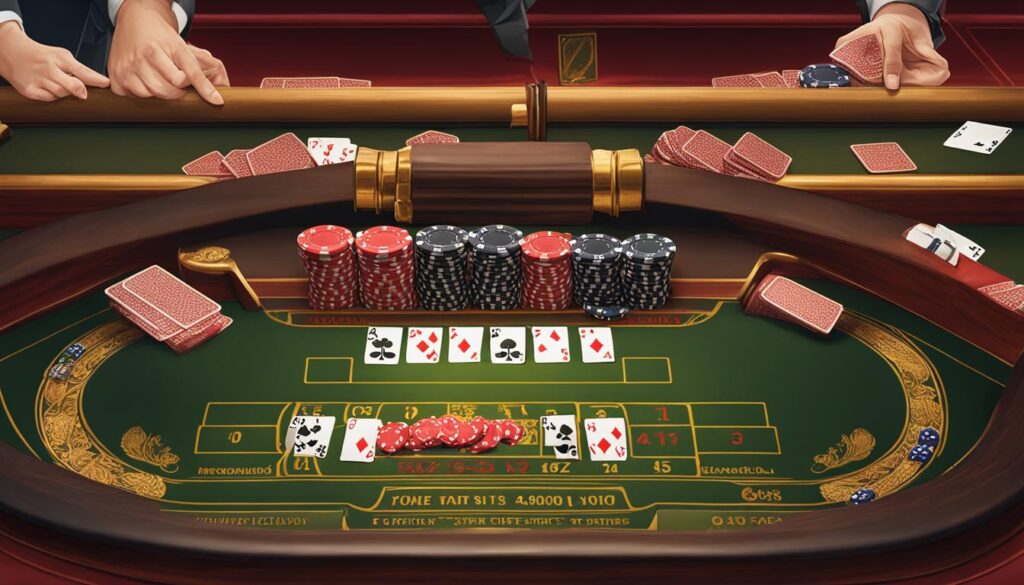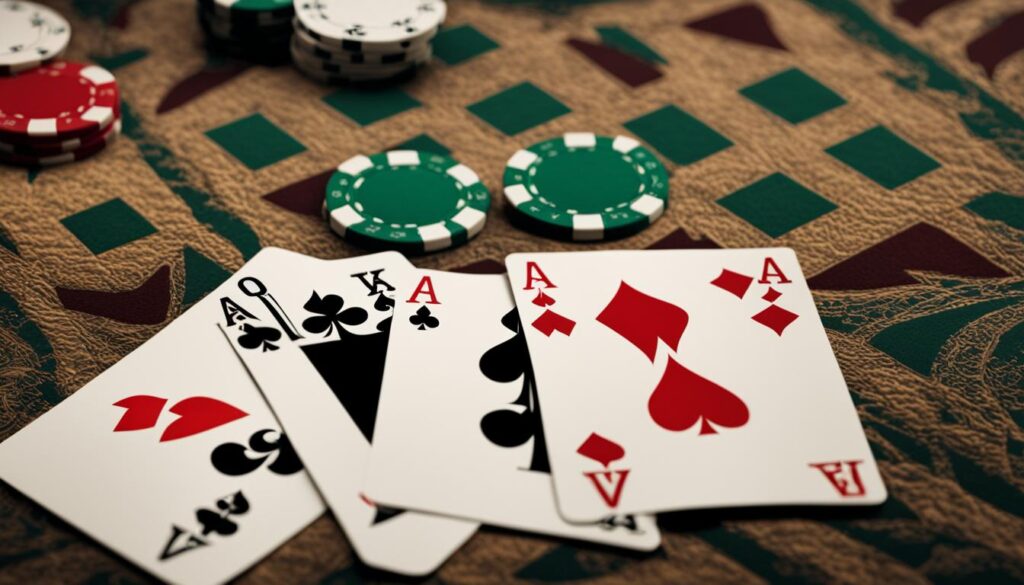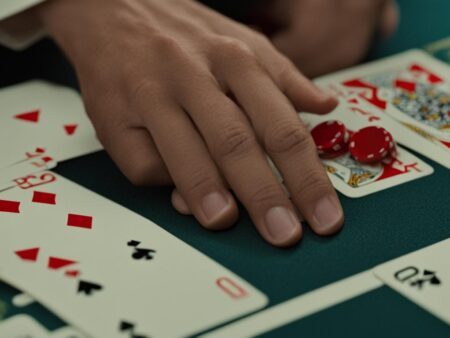In the game of blackjack, understanding the value of an ace is crucial. So, are aces 1 or 11 in blackjack? The answer is both. An ace can be counted as either 1 or 11, depending on the player’s strategy and the total value of their hand.
Blackjack, also known as 21, is a game where players aim to reach a hand total of 21 without going over. Aces play a pivotal role in achieving this goal, as they can be flexibly valued to suit the player’s needs.
Key Takeaways:
- Aces in blackjack can be worth either 1 or 11.
- The value of an ace depends on the player’s strategy and hand total.
- Blackjack, or 21, is the goal of the game.
- Aces add versatility and strategic options to players’ hands.
- Understanding the rules and proper use of aces can enhance your blackjack gameplay.
The Rules of Blackjack
In the exciting game of blackjack, players face off against the dealer in a quest to get a hand total closer to 21 than the dealer’s hand, without going over. Before any cards are dealt, players place their bets, and once the cards are drawn, no changes can be made. Blackjack is typically played with eight decks of 52 cards, increasing the challenge and adding an element of unpredictability.
Winning in blackjack requires not only luck but also a solid understanding of the rules. The objective is to have a hand total closer to 21 than the dealer’s hand. If a player’s hand goes over 21, they go bust and lose their wager. On the other hand, a blackjack, which consists of an ace and a picture card or a 10-value card, is the best possible hand and is paid at odds of 3 to 2.
During the game, players have the option to request additional cards to improve their hand total. They can draw as many cards as they want, as long as their total remains below 21. However, once a hand reaches 21, players cannot draw or double their wager. Conversely, the dealer must draw on totals of 16 or under and stand on totals of 17 or over.
Table 1: Blackjack Payouts
| Hand | Payout |
|---|---|
| Blackjack (Ace + Picture Card or 10-value card) | 3 to 2 |
| Winning Hand (Total closer to 21 than the dealer’s) | 1 to 1 |
| Push (Player and dealer have the same total) | Push (No win or loss) |
| Bust (Hand total exceeds 21) | Loss (Wager forfeited) |
To enhance your chances of winning, it’s crucial to understand the rules of blackjack. As we continue our exploration, we will dive deeper into the value of aces, busts and blackjacks, player actions, doubling down and splitting pairs, insurance and perfect pairs, and more. So stay tuned for the next sections as we uncover the secrets of successful blackjack gameplay.
The Value of Aces in Blackjack
In the game of blackjack, aces hold significant value and can greatly impact a player’s strategy. Aces can count as either 1 or 11, providing versatility and flexibility when determining the total value of the hand. It is essential to understand how aces are valued in order to make informed decisions during gameplay.
When it comes to card values in blackjack, court cards (kings, queens, and jacks) have a fixed value of 10. All other cards hold their face value. However, aces are unique because they can be counted as either 1 or 11. For example, if a player has an ace and a 6, the hand can be worth either 7 or 17, depending on how the player chooses to use the ace. This flexibility allows players to adapt their strategy based on the current situation.
The Value of Aces in Blackjack
| Card | Value |
|---|---|
| Ace | 1 or 11 |
| King, Queen, Jack | 10 |
| 2-10 | Face Value |
It is important to note that the value of aces in blackjack can change throughout the game. As the hand progresses and additional cards are drawn, the value of the ace may need to be adjusted to avoid exceeding a total of 21, known as going “bust.” The ability to switch the value of the ace from 11 to 1 (or vice versa) allows players to navigate these situations strategically and optimize their chances of winning.
In summary, aces are powerful cards in blackjack and can be worth either 1 or 11. Their value provides players with flexibility and the ability to adapt their strategy based on the current situation. Understanding the value of aces is crucial for making informed decisions during gameplay and maximizing the chances of winning.
Busts and Blackjacks
In the game of blackjack, understanding the concepts of busts and blackjacks is essential. A bust occurs when a player’s hand total exceeds 21, resulting in an automatic loss of the blackjack wager. On the other hand, a blackjack is the best possible hand, consisting of an ace and a picture card or a 10-value card. If a player has a blackjack, they are paid at odds of 3 to 2, unless the dealer also has a blackjack.
Knowing the odds of busting or getting a blackjack can significantly impact a player’s decisions during the game. The likelihood of busting depends on the current hand total and the upcoming cards. It is crucial to carefully consider the risks and potential rewards before taking additional cards.
Here is an example table showcasing the blackjack combinations and their corresponding payouts:
| Combination | Payout |
|---|---|
| Blackjack (ace + picture card or 10-value card) | 3 to 2 |
| Non-Blackjack Win | 1 to 1 |
| Push (tie) | Push (wager returned) |
| Bust | Loss of wager |
“The decision to hit or stand depends on the player’s assessment of the odds of busting versus the possibility of getting a blackjack. It’s all about weighing the risks and rewards.” – Blackjack Pro
Understanding the concept of busts and blackjacks allows players to make more informed decisions during gameplay. By carefully analyzing the odds, players can strategically manage their hand totals and increase their chances of winning in this exciting casino game.
Player Actions and Dealer Rules
In the game of blackjack, players have several actions they can take to enhance their chances of winning. These player actions include:
- Hit: This action involves requesting an additional card from the dealer to increase the total value of the hand. Players can continue hitting until their hand reaches a satisfactory total or they bust by exceeding 21.
- Stand: When a player chooses to stand, they are indicating that they are satisfied with their current hand and do not want any additional cards. This action is usually taken when the player believes their hand is strong enough to beat the dealer.
- Double Down: Doubling down allows the player to double their initial wager and receive one additional card. This action is commonly taken when the player has a strong hand and believes that one more card will give them a high chance of winning.
- Split: When a player is dealt a pair of cards with the same rank, such as two 8s or two 7s, they have the option to split them into two separate hands. This action requires an additional wager equal to the original bet and allows the player to play each hand independently.
- Insurance: If the dealer’s upcard is an ace, players have the option to take insurance. Insurance is a side bet that pays 2 to 1 if the dealer has blackjack. It is typically taken to protect the player’s original wager in case the dealer has a strong hand.
While players have a range of actions they can take, the dealer must abide by specific rules set by the casino. The dealer’s actions and rules in blackjack include:
- Hitting on 16 or less: If the dealer’s hand total is 16 or lower, they must draw an additional card. This rule ensures that the dealer continues to improve their hand and gives the player an opportunity to win.
- Standing on 17 or more: Once the dealer’s hand total reaches 17 or higher, they must stand and cannot draw any more cards. This rule is designed to prevent the dealer from busting and gives the player a chance to win if their hand total is higher.
- No doubling or splitting: Unlike players, the dealer does not have the option to double down or split their cards. Their actions are predetermined and based solely on the total value of their hand.
Understanding player actions and dealer rules is essential for developing a successful blackjack strategy. By knowing how to make the most of each action and understanding the limitations of the dealer, players can make informed decisions and increase their chances of winning.
Doubling Down and Splitting Pairs

In blackjack, players have the option to make strategic moves that can significantly impact their chances of winning. Two such moves are doubling down and splitting pairs. Let’s take a closer look at these actions and the rules that apply to them.
Doubling Down
Doubling down in blackjack allows players to double their original wager after receiving their first two cards. This is a bold move that can be particularly advantageous when a player has a strong hand and believes that only one more card is needed to beat the dealer. However, not all casinos allow doubling down on any hand. Some casinos have specific rules on when and how players can double down. It’s important to familiarize yourself with the specific rules of the casino you are playing at to make the most of this strategic move.
Splitting Pairs
When a player is dealt a pair of cards with the same value, such as two 6s or two 9s, they have the option to split the pair into two separate hands. This allows them to play each card as an individual hand and potentially double their chances of winning. However, not all pairs can be split. Most casinos allow players to split any pair except for a pair of aces. When a pair of aces is split, most casinos only allow one additional card to be drawn for each hand. Again, it’s crucial to check the specific rules of the casino regarding splitting pairs to make informed decisions during gameplay.
| Hand | Actions |
|---|---|
| Pair of Aces | Split (only one additional card per hand) |
| Pair of 2s, 3s, 6s, 7s, 8s | Split |
| Pair of 4s | Split (except against 5 or 6) |
| Pair of 5s | Never split |
| Pair of 9s | Split (except against 7, 10, or ace) |
| Pair of 10s | N/A (already a strong hand) |
As shown in the table, the decision to split pairs depends on the specific cards in hand and the dealer’s upcard. It’s crucial to understand the optimal strategy for splitting pairs to make the most of this strategic move.
“Doubling down and splitting pairs are two powerful moves in blackjack that can enhance a player’s chances of winning. However, both moves require careful consideration of the specific rules in play. By understanding the rules and the optimal strategy for doubling down and splitting pairs, players can make more informed decisions and improve their overall blackjack strategy.”
Insurance and Perfect Pairs
In certain variations of blackjack, players have the option to take insurance if the dealer’s first card is an ace. This side wager can protect against the dealer having blackjack and is paid at odds of 2 to 1 if the dealer does have blackjack. Taking insurance can be a strategic move to minimize potential losses in case the dealer has a strong hand.
Additionally, some blackjack games offer a Perfect Pairs wager for specific combinations of the player’s first two cards. This side bet pays out if the player’s initial cards are a pair, such as two kings of spades or two sevens of hearts. The payout for Perfect Pairs can vary depending on the specific casino or game rules.
Table: Blackjack Insurance and Perfect Pairs Payouts
| Insurance | Perfect Pairs |
|---|---|
| Dealer has blackjack | Perfect Pair |
| Pays 2 to 1 | Pays various odds, depending on the specific game |
“Taking insurance can be a smart move if the dealer’s face-up card is an ace, as it provides some protection against losing the entire bet. However, it’s important to consider the odds and the specific rules of the game before making this side wager.”
Both insurance and Perfect Pairs are optional side wagers in blackjack that add an extra layer of excitement and variety to the game. Players should carefully consider the potential outcomes and their own risk tolerance before deciding to place these side bets.
The Value of Two Aces

In the game of blackjack, being dealt two aces is an exciting occurrence. This powerful combination presents players with the opportunity to split their hand and potentially increase their chances of hitting blackjack. Splitting a pair of aces allows players to create two separate hands and receive additional cards for each. It’s a strategic move that can optimize gameplay and enhance the overall blackjack experience.
When a player chooses to split a pair of aces, each ace is treated as its own hand. The first ace is paired with another card, forming the first hand. The second ace then becomes the foundation for the second hand. This means that the initial bet is doubled, as it applies to both hands.
Splitting aces is advantageous primarily because of the flexibility they offer. Aces can be counted as either 1 or 11, depending on what benefits the player’s hand the most. By splitting a pair of aces, players have two chances at hitting blackjack, as each hand can potentially reach a total of 21 with just one more card. It’s important to note that blackjack achieved through a split hand is considered a regular blackjack, rather than a higher-paying natural blackjack.
Dealer’s Aces in Blackjack
When playing blackjack, one of the most challenging scenarios for players is when the dealer is dealt an ace as their first card. The value of the dealer’s aces differs from that of the player’s aces. Unlike players, who have the flexibility to choose between the values of 1 or 11 for their aces, the dealer follows specific rules.
When the dealer receives an ace as their first card, it automatically counts as 11, unless doing so would result in the dealer going over 21. This means that if the dealer has an ace and a 6, their hand value is 17. However, if the dealer draws another card and it is an ace, it will be counted as 1, ensuring that the dealer does not exceed a hand value of 21. The dealer will continue to draw additional cards according to the rules until they reach a total of 17 or higher.
Dealing with a dealer’s ace adds an extra layer of strategy to the game. Players must carefully consider their own hand value, the dealer’s upcard, and the probability of the dealer drawing another card with a value that will not exceed 21. This information can help players make informed decisions on whether to hit, stand, or employ other blackjack strategies.
The presence of a dealer’s ace in blackjack can significantly impact the outcome of a hand. It adds an element of uncertainty and requires players to make calculated choices. Understanding the value of the dealer’s aces is essential for players looking to improve their blackjack skills and increase their chances of winning.
Table: Dealer’s Ace Value in Blackjack
| Dealer’s Hand | Value of Ace |
|---|---|
| Ace + 6 | 11 |
| Ace + Ace | 12 |
| Ace + 5 + Ace | 16 |
| Ace + Ace + Ace | 13 |
Splitting Aces Twice in Blackjack
In most blackjack games, players can only split aces once. However, some casinos may allow players to split aces twice, giving them additional opportunities to win. It’s important to always check the specific rules of the casino regarding splitting aces.
Splitting aces is a strategic move that can significantly improve a player’s chances of winning in blackjack. By splitting the aces into two separate hands, the player can increase their chances of getting a blackjack, which consists of an ace and a 10-value card. This powerful hand is paid at odds of 3 to 2 and is the best possible outcome in the game.
When a player splits a pair of aces, they usually receive only one additional card for each hand. However, in some blackjack games where splitting aces twice is allowed, players have the opportunity to further enhance their hands. This can be a game-changer, as it gives players multiple chances to reach a total of 21 and beat the dealer.
It’s worth noting that not all casinos allow players to split aces twice, so it’s essential to verify the rules before placing a wager. Additionally, it’s important to consider the overall strategy and potential outcomes before deciding to split aces, as it may not always be the optimal move depending on the specific situation.
Table: Rules for Splitting Aces in Blackjack
| Blackjack Variation | Rule |
|---|---|
| Standard Blackjack | Players can only split aces once. |
| Blackjack Variation 1 | Players can split aces twice. |
| Blackjack Variation 2 | Players can split aces twice. |
| Blackjack Variation 3 | Players can only split aces once. |
Proper Use of Aces in Blackjack
In the game of blackjack, aces are highly versatile and can greatly impact a player’s strategy. Understanding the proper use of aces is essential to maximize the chances of winning. When faced with the decision of how to use an ace, players should consider the total value of their hand and the potential outcomes.
One key factor to consider is whether counting the ace as 1 or 11 will give the player the best advantage. This decision should be based on the player’s hand and the dealer’s up card. For example, if a player has a hand total of 12 and the dealer’s up card is a 6, it may be wise to count the ace as 1 to avoid the risk of busting. On the other hand, if a player has a hand total of 17 and the dealer’s up card is a 4, counting the ace as 11 can increase the chances of reaching 21 without going over.
Another important aspect of using aces in blackjack is knowing when to split them. Splitting a pair of aces gives the player two separate hands and two chances at reaching blackjack. This is particularly advantageous when the dealer’s up card is weak. However, it’s important to note that some casinos may restrict splitting aces to only one additional card per hand.
Proper Use of Aces in Blackjack – Summary
- Consider the total value of your hand and the dealer’s up card when deciding how to use an ace.
- Counting the ace as 1 or 11 depends on the situation and the risk of busting.
- Splitting a pair of aces gives you two chances at reaching blackjack, but be aware of casino restrictions on splitting aces.
| Hand Total | Dealer’s Up Card | Recommended Use of Ace |
|---|---|---|
| 12 | 6 | Count ace as 1 to avoid busting |
| 17 | 4 | Count ace as 11 to increase chances of reaching 21 |
Properly utilizing aces in blackjack is crucial for success. It requires careful consideration of the hand value, the dealer’s up card, and the potential outcomes. By making strategic decisions when using aces, players can increase their chances of winning and create a more enjoyable blackjack experience.
Play Aces Carefully in Blackjack
When it comes to playing blackjack, aces are undoubtedly powerful cards that can greatly impact the outcome of a game. However, their versatility also comes with the need for caution and careful decision-making. With a value of either 1 or 11, aces can either help you achieve a winning hand or lead you to exceed 21 and bust.
Having the flexibility to choose between 1 or 11 for the value of an ace gives players the opportunity to strategize and optimize their gameplay. The decision of how to use an ace should depend on your current hand total and the dealer’s hand. It’s important to assess the risks and rewards of each option to minimize the chance of going bust and increase the likelihood of beating the dealer.
One strategy to consider is to count the ace as 11 when it gives you a strong hand total without the risk of going over 21. This can create the potential for reaching blackjack and winning the game. On the other hand, if counting the ace as 11 would put your hand at risk of busting, it’s wise to count it as 1 to stay in the game and continue playing strategically.
Remember, playing aces carefully in blackjack requires thoughtful consideration of the current game situation. Always weigh the potential outcomes and choose the option that reduces your risk of going bust and maximizes your chances of beating the dealer. With a strategic approach to using aces, you can enhance your gameplay and increase your chances of success.
Note: The image above visualizes the importance of playing aces carefully in blackjack and emphasizes the strategic decisions players must make when faced with an ace card. It serves as a visual representation of the topic discussed in this section.
Conclusion
In conclusion, the value of aces in blackjack can have a significant impact on a player’s strategy and overall gameplay. Aces can be worth either 1 or 11, allowing for flexibility in reaching the target total of 21. By carefully considering the total value of their hand and the potential outcomes, players can optimize their chances of winning.
Splitting a pair of aces can be a strategic move, as it provides two opportunities to hit blackjack. However, it’s important to note that some casinos may restrict splitting aces to just once, so players should always be aware of the specific rules of the game they are playing.
To make the best use of aces in blackjack, players should exercise caution and assess the risk of going bust. By choosing the option that minimizes the risk and maximizes the chances of beating the dealer, players can enhance their blackjack experience and improve their overall success rate.
FAQ
Are aces worth 1 or 11 in blackjack?
Aces in blackjack can be worth either 1 or 11, depending on the player’s strategy and the total value of their hand.
What are the rules of blackjack?
In blackjack, players play against the dealer or house. Bets are placed before any cards are dealt, and the objective is to have a hand total closer to 21 than the dealer’s hand without going over.
How do aces count in blackjack?
Aces count as either 1 or 11 in blackjack. The decision of how to use an ace is up to the player and can greatly impact their strategy.
What happens if a player goes over 21?
If a player’s hand total goes over 21, they bust and lose their blackjack wager.
What is a blackjack?
A blackjack is a hand consisting of an ace and a picture card or a 10-value card. It is the best possible hand in blackjack and is paid at odds of 3 to 2.
Can players draw additional cards in blackjack?
Yes, players have the option to draw additional cards to get closer to 21. However, once a hand reaches 21, players cannot draw or double.
Can players double their original bet in blackjack?
Yes, players have the option to double their original stake on their first two cards, except for pairs of aces.
Can players split their cards in blackjack?
Yes, if a player’s first two cards are a pair, they can choose to split them into two separate hands. However, splitting aces usually allows for only one additional card to be drawn for each hand.
What is insurance in blackjack?
Insurance is a side wager in blackjack that can be taken if the dealer’s first card is an ace. It protects against the dealer having blackjack and is paid at odds of 2 to 1 if the dealer does have blackjack.
What should players do when dealt two aces in blackjack?
When dealt two aces in blackjack, it is recommended to split them into two separate hands to maximize the chances of hitting blackjack.
How does the dealer’s ace count in blackjack?
When the dealer has an ace as their first card, it counts as 11 unless it would bust their hand. Subsequent aces for the dealer will be worth 1 to ensure they don’t go over 21.
Can players split aces more than once in blackjack?
In most blackjack games, players can only split aces once. However, some casinos may allow players to split aces twice, giving them additional opportunities to win.
How should players use aces in blackjack?
Aces should be used strategically in blackjack to maximize the chances of winning. Players should consider the total value of their hand and whether counting the ace as 1 or 11 will give them the best advantage.
What should players be cautious of when playing aces in blackjack?
Players should exercise caution when playing aces in blackjack. It’s important to consider the potential outcomes and choose the option that reduces the risk of going bust and increases the chances of beating the dealer.







